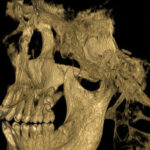Dry socket is a condition that occurs after you have had one or more teeth removed. The blood clot that forms over the site of the extraction dislodges; the resulting dry socket leaves bone and nerves exposed to outside forces. Dry socket can be a very painful experience, and occurs in approximately five percent of all tooth extractions, even more in wisdom teeth. Dry socket rarely leads to infection or further complications, but can be very unpleasant until the pain can be brought under control.
After a tooth is extracted, a blood clot will form, serving as a protective layer over the bone beneath where the tooth was and the exposed nerve endings in the now empty tooth socket. This clot affords the basis for the growth of new tissue and bone, but in some instances, the clot does not form properly or becomes dislodged before the healing process can be completed. The area is now exposed to the open air, and whatever food particles and fluids that come into contact with it. The consequence can be extreme pain, which can travel along the nerves that branch out to the ear and eye on that side of your face. There are several factors believed to contribute to dry socket, including potential bacterial contamination of the socket, whether the extraction was easy of difficult, and if the roots of the tooth or bone bits remain in the wound following surgery. The blood clot can be dislodged by sneezing, sucking actions from coughing, spitting, or smoking, or by not explicitly following the directions given to care for the area after the tooth is removed.
Smoking and the use of tobacco products can increase your chances of having dry socket, as the chemicals in cigarettes and other types of tobacco products can contaminate the wound immediately after surgery. Women taking oral contraceptives are at a higher risk of developing dry socket, as the elevated estrogen level can aid in dissolving the protective blood clot. Also, women in the first twenty-two days of their menstrual cycle are twice as prone to dry socket due to the higher estrogen amounts in their system. Refusing to avoid certain foods right after your surgery can contribute to dry socket; if you have had the condition in the past, chances are good that you will again.
Besides the obvious drawback of intense pain resulting from a case of dry socket, the condition also delays the healing process in your mouth. Gum tissue takes an average of three to four weeks to heal completely, and bone can take as long as six months; dry socket keeps this from starting as quickly as it should. Infection is not common in dry socket, but can occur in rare circumstances. The rescheduling of other dental procedures that need to be done because of dry socket can be very inconvenient and frustrating. Dry socket is treated with the alleviation of the pain in mind. Towards that end, you may be given pain medications. If over-the-counter meds do not do the job, you may need a prescription for something stronger. The dry socket will be packed with medicated dressings by your dentist or oral surgeon, and these will need to be changed frequently and correctly to provide the most relief and healing. Any food debris that has collected in the dry socket will have to be rinsed away first, and you will be given instructions on how to do this at home with a plastic syringe and whatever solution the dentist recommends. Your pain symptoms should begin to dissipate once treatment has been administered, and if all goes well, your dry socket will be gone in ten days to two weeks.
One would think with all the advances in medicine, a fail-safe way to prevent dry socket would have been on the list somewhere, but such is not the case. Some dentists and oral surgeons will treat the area of the extraction before and after with antibiotics to make the chance of dry socket occurring lesser, but some researchers believe this practice helps to develop antibiotic-resistant bacteria in the long run. To better your odds against dry socket, be sure that you have an experienced individual removing the tooth. Women can try to have the tooth taken out twenty-three to twenty-eight days into their menstrual cycles if they use oral contraceptives, and smokers should make the attempt to refrain from smoking at least one full day before the extraction date. If you are taking any medications that have anti-clotting side effects, you need to let your dentist know. After the tooth is gone, avoid spitting for the first couple of days, and resist the temptation to touch the area with your tongue or fingers. Do not use a straw to drink for a while and stay away from carbonated beverages for at least three days after the removal of the tooth. Brush your teeth gently, especially near the site of the blood clot, and try to chew food on the side of the mouth opposite from where the tooth was taken. You are just asking for dry socket if you try to consume foods that cause residual particles. Do not eat foods like peanuts, potato chips, popcorn, or pasta. Instead, opt for meals that include clear or cream soups, mashed potatoes, and the like. Dry socket is bad enough when it happens on its own, so don’t make it easier for it to occur.




